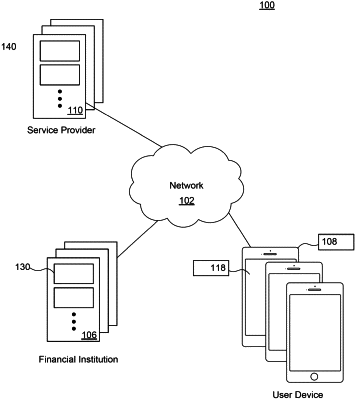| CPC G06Q 20/108 (2013.01) [G06N 20/00 (2019.01); G06Q 20/3221 (2013.01); G06Q 20/3223 (2013.01); G06Q 20/405 (2013.01); G06Q 20/4037 (2013.01); G06Q 30/0283 (2013.01); G06Q 40/02 (2013.01); G06Q 20/023 (2013.01); G06Q 30/0185 (2013.01); G06Q 50/01 (2013.01)] | 20 Claims |

|
1. A system comprising:
a memory storing instructions;
a database, in electronic communication with the memory, configured to store information comprising:
account information associated with an account at a financial institution;
user information for a user associated with the account;
a mobile device unique identifier for a mobile device associated with the user;
an account balance associated with the account; and
a processor, in electronic communication with the database, configured to execute the instructions to perform operations associated with a first mode or a second mode, the first mode being a separate and distinct mode from the second mode, comprising:
associating the mobile device unique identifier with the account based on the account information;
providing a user interface accessible via the mobile device;
providing a first dashboard configuration for display in the user interface, the first dashboard configuration being configured to process a plurality of electronic transactions related to the financial account;
generating, using a machine learning algorithm, a prediction indicating whether the account balance will dip below a predetermined value, wherein a user's spending habits, a user's personal account balance, and a user's geolocation are used as inputs for the machine learning algorithm;
determining, based on the prediction, whether the account balance is below the predetermined value;
upon determining whether the account balance is below the predetermined value, entering the account into the second mode;
determining a grace period indicating a period of time;
in response to the determination that the account is in the second mode disabling the first dashboard configuration, and enabling a second dashboard configuration associated with the user interface;
permitting the user to navigate only within the second dashboard configuration to perform a limited set of electronic banking operations associated with payment controls;
rejecting attempted payments when the account is in the second mode through payment controls associated with the grace period, and displaying the payment controls on the second dashboard configuration, wherein the payment controls consist of:
spending control;
automatic locking;
danger day setting; and
geolocation setting;
transmitting a notification to the mobile device for display through the user interface on the second dashboard configuration, based on the determination that the account balance is below the predetermined value, the notification indicating:
that the account balance is below the predetermined value and the grace period;
determining whether the grace period is expired;
responsive to determining that the grace period is expired, enabling the first dashboard configuration;
and
charging an overdraft fee to the account based on the determination that the grace period is expired.
|